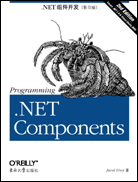
.NET组件开发(第二版,影印版)
出版时间:2006年04月
页数:624
本书作为.NET组件开发的权威参考书,自2003年出版以来就广受程序员的关注。
如今,您手上的是《.NET组件开发》的第二版。针对Visual Studio 2005和.NET 2.0,作者Juval Lowy对本书进行了全面修订。不仅使第一版中经典内容的阐述更加充实,而且增加了许多新的热点内容,如Generics的开发、迭代器和匿名方法的使用、.NET开发框架的演进等。书中详尽的阐述和代码实例将极大地帮助您加深对.NET组件开发的理解。
本书更具特色的内容有:关于Generics编程的介绍;作为业界事实标准的C#语言的编码规范;许多实用的辅助类和控制集,如基于ASP.NET 2.0凭证管理架构下的安全控制解决方案等。同时作者改写并扩展了原书第一版中许多实用的辅助类和工具。
具体内容包括:
● .NET组件的构建、打包及部署
● 接口与实现的分离
● 生命周期和资源的管理
● 事件的发布及订阅
● 异步调用的使用
● 多线程和并发管理
● 对象的序列化及状态的持久化
● 远程调用
● 定制服务的实现
● 构建安全性解决方案
本书极具价值的代码实例、丰富的使用技巧、开发警示、设计准则和富有创意的实用工具将帮助您简化开发工作并提高.NET组件的开发效率。无论您已经在使用组件技术还是正准备进入这个领域,毫无疑问,《.NET组件开发》都是一本值得拥有和时常翻阅的参考指南。
Juval Lowy是IDesign公司(该公司为客户提供基于.NET技术的咨询和培训服务)的首席软件架构师。同时作为微软开发社区中的知名专家,鉴于他在.NET解决方案设计及实施中的杰出贡献,微软公司授予其“软件英杰”(Software Legend)的杰出荣誉。
如今,您手上的是《.NET组件开发》的第二版。针对Visual Studio 2005和.NET 2.0,作者Juval Lowy对本书进行了全面修订。不仅使第一版中经典内容的阐述更加充实,而且增加了许多新的热点内容,如Generics的开发、迭代器和匿名方法的使用、.NET开发框架的演进等。书中详尽的阐述和代码实例将极大地帮助您加深对.NET组件开发的理解。
本书更具特色的内容有:关于Generics编程的介绍;作为业界事实标准的C#语言的编码规范;许多实用的辅助类和控制集,如基于ASP.NET 2.0凭证管理架构下的安全控制解决方案等。同时作者改写并扩展了原书第一版中许多实用的辅助类和工具。
具体内容包括:
● .NET组件的构建、打包及部署
● 接口与实现的分离
● 生命周期和资源的管理
● 事件的发布及订阅
● 异步调用的使用
● 多线程和并发管理
● 对象的序列化及状态的持久化
● 远程调用
● 定制服务的实现
● 构建安全性解决方案
本书极具价值的代码实例、丰富的使用技巧、开发警示、设计准则和富有创意的实用工具将帮助您简化开发工作并提高.NET组件的开发效率。无论您已经在使用组件技术还是正准备进入这个领域,毫无疑问,《.NET组件开发》都是一本值得拥有和时常翻阅的参考指南。
Juval Lowy是IDesign公司(该公司为客户提供基于.NET技术的咨询和培训服务)的首席软件架构师。同时作为微软开发社区中的知名专家,鉴于他在.NET解决方案设计及实施中的杰出贡献,微软公司授予其“软件英杰”(Software Legend)的杰出荣誉。
- Preface
- 1. Introducing Component-Oriented Programming
- Basic Terminology
- Component-Oriented Versus Object-Oriented Programming
- Principles of Component-Oriented Programming
- .NET Adherence to Component Principles
- Developing .NET Components
- 2. .NET Component-Oriented Programming Essentials
- Language Independence: The CLR
- Packaging and Deployment: Assemblies
- Binary Compatibility
- 3. Interface-Based Programming
- Separating Interface from Implementation
- Working with Interfaces
- Interfaces and Generics
- Designing and Factoring Interfaces
- Interfaces in Visual Studio 2005
- 4. Lifecycle Management
- The Managed Heap
- Traditional Memory De-allocation Schemas
- .NET Garbage Collection
- Object Finalization
- Deterministic Finalization
- 5. Versioning
- Assembly Version Number
- Assembly Deployment Models
- Strong Assembly Names
- Visual Studio 2005 and Versioning
- Custom Version Policies
- CLR Versioning
- 6. Events
- Delegate-Based Events
- Working with .NET Events
- 7. Asynchronous Calls
- Requirements for an Asynchronous Mechanism
- Revisiting Delegates
- Asynchronous Call Programming Models
- Asynchronous Error Handling
- Asynchronous Events
- Asynchronous Invocation Pitfalls
- Synchronous Versus Asynchronous Processing
- 8. Multithreading and Concurrency Management
- Threads and Multithreading
- Components and Threads
- Working with Threads
- Synchronizing Threads
- Automatic Synchronization
- Manual Synchronization
- The WorkerThread Wrapper Class
- Synchronizing Delegates
- Using .NET Multithreading Services
- 9. Serialization and Persistence
- Automatic Serialization
- Serialization Formatters
- Serialization Events
- Serialization and Streams
- Custom Serialization
- Serialization and Class Hierarchies
- 10. Remoting
- Application Domains
- Remote Object Types
- Marshaling-by-Reference Activation Modes
- The .NET Remoting Architecture
- Building a Distributed Application
- Leasing and Sponsorship
- .NET and Location Transparency
- 11. Context and Interception
- .NET Component Services
- The .NET Context
- Custom Component Services
- 12. Security
- The .NET Security Architecture
- Configuring Permissions
- Programmatic Security
- Visual Studio 2005 and Security
- Principal-Based Security
- Addressing Other Security Issues
- A. Interface-Based Web Services
- B. Unifying Windows Forms and ASP.NET Security
- C. Reflection and Attributes
- D. Generics
- E. C# Coding Standard
- Index
书名:.NET组件开发(第二版,影印版)
作者:Juval Lowy 著
国内出版社:东南大学出版社
出版时间:2006年04月
页数:624
书号:7-5641-0274-8
原版书出版商:O'Reilly Media
The animal on the cover of Programming .NET Components, Second Edition, is a
land hermit crab (Coenobita clypeatus). Land hermit crabs are found in tropical areas
of the Indo-region, the western Atlantic, and the western Caribbean. They live close
to the shoreline and must have access to land and water.
The front half of a hermit crab is covered with a hard exoskeleton. The long
abdomen has a softer exoskeleton that can adjust to fit into a spiraled shell. The large
left claw is used for defense, for holding onto tree limbs, and for balance. The smaller
right claw and the next pair of appendages are used for collecting and passing food
and water to the mouth. Hermit crabs have stalked eyes with acute vision and two
pairs of antennae. The longer pair of antennae is used for feeling, the shorter for
smelling and tasting.
The land hermit crab doesn’t have a hard shell of its own; it uses old empty shells to
protect its soft body. As it grows in size, the hermit crab must find a larger shell.
When danger threatens, it hides in the shell and closes the entrance with its hard
claw. Hermit crabs are omnivores and scavengers. They eat worms, plankton, and
organic debris.
Although land-based, these crabs must return to the sea to breed. Both males and
females partially emerge from their shells to mate. The female lays her hundreds of
eggs inside the borrowed shell. These eggs are safe and damp in the shell but, when
they hatch, they must be released in the sea. The young are in danger until they find
a shell of their own. When they reach adulthood, the crabs migrate to begin their
terrestrial life. Land hermit crabs live about 10 years.
land hermit crab (Coenobita clypeatus). Land hermit crabs are found in tropical areas
of the Indo-region, the western Atlantic, and the western Caribbean. They live close
to the shoreline and must have access to land and water.
The front half of a hermit crab is covered with a hard exoskeleton. The long
abdomen has a softer exoskeleton that can adjust to fit into a spiraled shell. The large
left claw is used for defense, for holding onto tree limbs, and for balance. The smaller
right claw and the next pair of appendages are used for collecting and passing food
and water to the mouth. Hermit crabs have stalked eyes with acute vision and two
pairs of antennae. The longer pair of antennae is used for feeling, the shorter for
smelling and tasting.
The land hermit crab doesn’t have a hard shell of its own; it uses old empty shells to
protect its soft body. As it grows in size, the hermit crab must find a larger shell.
When danger threatens, it hides in the shell and closes the entrance with its hard
claw. Hermit crabs are omnivores and scavengers. They eat worms, plankton, and
organic debris.
Although land-based, these crabs must return to the sea to breed. Both males and
females partially emerge from their shells to mate. The female lays her hundreds of
eggs inside the borrowed shell. These eggs are safe and damp in the shell but, when
they hatch, they must be released in the sea. The young are in danger until they find
a shell of their own. When they reach adulthood, the crabs migrate to begin their
terrestrial life. Land hermit crabs live about 10 years.
购买选项